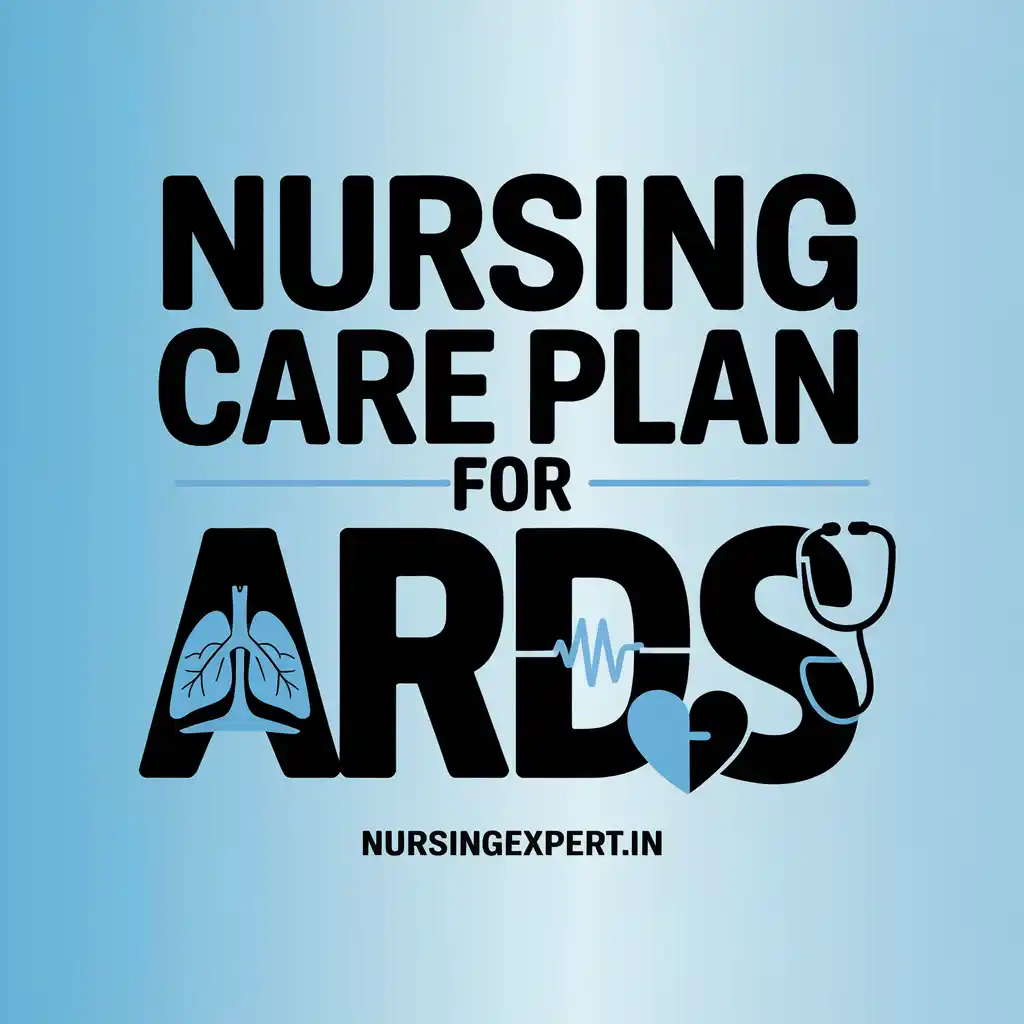Acute Respiratory Distress Syndrome (ARDS) is a critical condition marked by severe inflammation and fluid accumulation in the lungs, leading to impaired gas exchange and hypoxemia. A well-organized nursing care plan for Acute Respiratory Distress Syndrome (ARDS provides a structured framework to assess patients, set measurable goals, and implement targeted interventions that optimize respiratory function and improve outcomes. This guide details the pathophysiology, etiology, signs and symptoms, nursing diagnoses, and key interventions for ARDS. A downloadable PDF version of the care plan is available for clinical practice and exam preparation.
Thank you for reading this post, don't forget to subscribe!
1. Introduction
Acute Respiratory Distress Syndrome (ARDS) is a life-threatening condition characterized by rapid-onset respiratory failure due to widespread inflammation in the lungs. Effective management is crucial to restore adequate oxygenation and prevent further complications. Nurses use a nursing care plan for ARDS to systematically evaluate respiratory status, implement targeted interventions, and provide comprehensive care. This guide offers a detailed approach to ARDS management, with a downloadable PDF resource available for clinical practice and exam preparation.


2. Understanding ARDS
ARDS is a severe pulmonary condition that develops when the alveoli are flooded with protein-rich fluid, compromising gas exchange. It often follows critical illnesses such as sepsis, trauma, or pneumonia. Patients with ARDS experience significant respiratory distress, which can rapidly progress to respiratory failure. A targeted care plan assists nurses in promptly identifying symptoms, initiating life-saving interventions, and supporting recovery.
3. Pathophysiology of ARDS
In ARDS, an initial injury—whether from infection, trauma, or inflammation—leads to a cascade of events:
- Inflammatory Response: The release of cytokines increases vascular permeability in the alveolar-capillary membrane.
- Pulmonary Edema: Fluid accumulates in the alveoli, impairing gas exchange.
- Reduced Lung Compliance: The lungs become stiff, making breathing laborious.
- Hypoxemia: Inadequate oxygenation results from impaired diffusion of oxygen into the bloodstream. A clear understanding of these processes is vital for planning effective nursing interventions.
4. Etiology of ARDS
ARDS can be triggered by a variety of direct and indirect insults, including:
- Sepsis: Systemic infection is a leading cause.
- Pneumonia: Bacterial or viral lung infections can precipitate ARDS.
- Trauma: Severe injuries, especially those involving the chest.
- Aspiration: Inhalation of gastric contents.
- Pancreatitis: Inflammatory response from pancreatic injury. Recognizing these etiological factors allows nurses to tailor the nursing care plan for ARDS to individual patient needs.
5. Signs and Symptoms
Patients with ARDS may exhibit:
- Severe Shortness of Breath: Rapid, labored breathing.
- Tachypnea: Increased respiratory rate.
- Hypoxemia: Low oxygen saturation despite supplemental oxygen.
- Cyanosis: Bluish discoloration of the skin and mucous membranes.
- Diffuse Lung Crackles: Abnormal lung sounds on auscultation.
- Fatigue and Confusion: Due to inadequate oxygen delivery to tissues. Early identification of these signs is critical for timely intervention.
6. Nursing Diagnoses for ARDS
Based on NANDA guidelines, common nursing diagnoses for ARDS include:
- Impaired Gas Exchange related to alveolar flooding and inflammation as evidenced by low oxygen saturation and abnormal lung sounds.
- Ineffective Breathing Pattern related to decreased lung compliance and increased work of breathing.
- Risk for Decreased Cardiac Output related to hypoxemia and increased cardiac workload.
- Anxiety related to fear of respiratory failure and uncertainty about recovery.
- Deficient Knowledge regarding disease management and self-care strategies. These diagnoses form the foundation for an effective nursing care plan for ARDS.
7. Nursing Interventions for ARDS
Key nursing interventions for ARDS aim to optimize oxygenation, reduce inflammation, and support overall respiratory function:
- Monitor Respiratory and Hemodynamic Status:
Regularly assess respiratory rate, oxygen saturation, blood pressure, and heart rate.
Rationale: Continuous monitoring provides early detection of deterioration. - Administer Supplemental Oxygen and Ventilatory Support:
Provide oxygen therapy, and assist with mechanical ventilation as prescribed.
Rationale: Enhancing oxygen delivery is critical for tissue perfusion. - Positioning:
Place the patient in a semi-Fowler’s position to maximize lung expansion.
Rationale: Proper positioning improves ventilation and reduces work of breathing. - Administer Medications:
Provide prescribed anti-inflammatory agents, bronchodilators, and sedatives if necessary.
Rationale: Medications reduce inflammation and facilitate improved gas exchange. - Fluid Management:
Monitor fluid balance carefully and adjust IV fluid administration to prevent pulmonary edema.
Rationale: Maintaining optimal fluid balance is essential for minimizing lung injury. - Pain and Anxiety Management:
Administer analgesics and anxiolytics as ordered and use relaxation techniques.
Rationale: Reducing pain and anxiety helps lower metabolic demand and improves respiratory function. - Patient Education:
Educate the patient and family on the importance of follow-up care, proper use of oxygen therapy, and strategies to manage anxiety.
Rationale: Empowered patients are better equipped to participate in their care.
8. Nursing Management Strategies
A comprehensive management strategy for ARDS involves:
- Initial Evaluation:
Conduct a thorough assessment of the patient’s respiratory status and review baseline laboratory values. - Continuous Monitoring:
Regularly track vital signs, oxygen saturation, and patient responsiveness. - Early and Aggressive Intervention:
Initiate oxygen therapy, medications, and ventilatory support promptly. - Patient and Family Education:
Provide clear, concise instructions on treatment regimens and self-care practices. - Follow-Up and Reassessment:
Schedule regular reassessments to monitor progress and modify interventions as needed. - Interdisciplinary Collaboration:
Work with respiratory therapists, intensivists, pharmacists, and dietitians to deliver holistic care. This approach ensures the nursing care plan for ARDS is effective and adaptable.
9. Patient and Family Education
Effective education is vital in managing ARDS:
- Explain the Condition:
Clearly describe what ARDS is, its causes, and its potential complications. - Medication and Ventilator Management:
Teach the patient and family about the importance of adhering to prescribed treatments and how to use equipment properly. - Symptom Monitoring:
Instruct on signs of deterioration such as increased breathlessness or changes in vital signs. - Lifestyle Modifications:
Advise on rest, nutrition, and gradual mobilization as part of recovery. - When to Seek Help:
Emphasize the importance of immediate medical attention if symptoms worsen. This education empowers patients and families to actively participate in care and supports better outcomes.
10. Interdisciplinary Collaboration
Managing ARDS requires a team effort. Nurses should collaborate with:
- Respiratory Therapists:
To optimize oxygen delivery and adjust ventilator settings. - Physicians/Intensivists:
To monitor the patient’s clinical status and modify treatment plans. - Pharmacists:
To ensure safe medication administration and manage drug interactions. - Dietitians:
To provide nutritional support tailored to the patient’s metabolic needs. - Patient Educators:
To reinforce self-care practices and provide instructional materials. - Social Workers:
To assist with accessing support services and resources. This interdisciplinary approach ensures comprehensive, patient-centered care.
11. Sample Nursing Care Plan for ARDS
Below is a sample nursing care plan for ARDS, organized into clear, actionable steps:
| Assessment | Nursing Diagnosis | Goal/Expected Outcome | Intervention/Planning | Implementation | Rationale | Evaluation |
|---|---|---|---|---|---|---|
| Subjective Data: – Patient reports severe shortness of breath and chest tightness. Objective Data: – Respiratory rate is 32/min; oxygen saturation is 85%; diffuse crackles heard on auscultation. | Impaired Gas Exchange related to alveolar flooding and decreased lung compliance as evidenced by low oxygen saturation and abnormal lung sounds. | Short-Term: – Within 1 hour, increase oxygen saturation to ≥92% and decrease respiratory rate. Long-Term: – Patient maintains stable oxygenation and improved lung function. | Initiate supplemental oxygen therapy; adjust ventilator settings if applicable; reposition patient in semi-Fowler’s position. | Administer oxygen via nasal cannula or mask; reassess vital signs and oxygen saturation every 15 minutes; document changes. | Supplemental oxygen and proper positioning enhance alveolar ventilation and improve gas exchange. | Oxygen saturation improves; respiratory rate decreases; patient reports reduced breathlessness. |
| Subjective Data: – Patient appears anxious and experiences discomfort due to persistent cough. Objective Data: – Elevated heart rate; patient shows signs of distress; increased work of breathing observed. | Anxiety related to respiratory distress as evidenced by verbal expressions of worry and elevated heart rate. | Short-Term: – Within 1 hour, patient reports reduced anxiety and improved comfort. Long-Term: – Patient uses effective coping strategies and maintains a calm state during treatment. | Provide emotional support and teach relaxation techniques such as deep breathing and guided imagery; use reassurance and clear communication. | Engage in one-on-one counseling; encourage the use of relaxation exercises; monitor heart rate and anxiety levels. | Reducing anxiety can lower sympathetic stimulation and contribute to improved respiratory function. | Patient reports decreased anxiety; heart rate stabilizes; patient demonstrates effective coping techniques. |
| Subjective Data: – Patient is uncertain about the management of their condition at home. Objective Data: – Patient asks questions regarding medication, nutrition, and follow-up care; appears confused about treatment protocols. | Deficient Knowledge regarding the management of ARDS as evidenced by patient uncertainty and questions about self-care practices. | Short-Term: – Within 24 hours, patient will verbalize understanding of key self-care strategies. Long-Term: – Patient adheres to the prescribed care plan and attends regular follow-up appointments. | Develop a comprehensive education plan that includes information on ARDS, medication adherence, nutritional support, and breathing techniques; provide written and visual aids. | Conduct individual teaching sessions; distribute educational materials; schedule follow-up discussions to reinforce learning. | Education empowers patients to manage their condition effectively and promotes treatment adherence. | Patient demonstrates increased understanding; self-care practices improve; follow-up assessments confirm consistent adherence. |
12. Downloadable Nursing Care Plan for ARDS PDF Download
Nursing Care Plan for ARDS PDF Download
Access our complete nursing care plan for ARDS PDF download. This comprehensive resource provides detailed, step-by-step instructions, NANDA-based nursing diagnoses, targeted interventions, and patient education strategies to manage ARDS effectively. Use this document for clinical practice or exam preparation.
📥 Download Nursing Care Plan for ARDS PDF
13. Frequently Asked Questions (FAQs)
- What is Acute Respiratory Distress Syndrome (ARDS)?
ARDS is a severe inflammatory condition of the lungs that leads to impaired gas exchange and hypoxemia. - What are common signs and symptoms of ARDS?
Symptoms include rapid, labored breathing, low oxygen saturation, diffuse lung crackles, and cyanosis. - What is the primary goal of a nursing care plan for ARDS?
The main goal is to restore effective gas exchange, stabilize oxygenation, and reduce respiratory distress. - Which interventions are most effective in managing ARDS?
Key interventions include supplemental oxygen therapy, proper positioning, medication administration, and patient education on breathing techniques. - How do nurses evaluate the success of an ARDS care plan?
Success is measured by improved oxygen saturation, stabilized respiratory rate, reduced patient distress, and positive feedback from the patient.
14. Conclusion
A structured nursing care plan for ARDS is essential for optimizing respiratory function and supporting overall recovery. Through comprehensive assessments, targeted interventions, and effective patient education, nurses can stabilize patients and significantly improve outcomes. This guide serves as a valuable resource for clinical practice and exam preparation.
15. References and Sources
- Mayo Clinic. (2023). Acute Respiratory Distress Syndrome (ARDS): Overview and Treatment. Retrieved from https://www.mayoclinic.org/diseases-conditions/ards
- MedlinePlus. (2023). Acute Respiratory Distress Syndrome. Retrieved from https://medlineplus.gov/ards.html
- NANDA International. (2022). NANDA Nursing Diagnoses: Definitions and Classifications. Retrieved from https://www.nanda.org/
- American Lung Association. (2023). Understanding ARDS. Retrieved from https://www.lung.org/lung-health-diseases/lung-disease-lookup/ards
- Centers for Disease Control and Prevention (CDC). (2023). Respiratory Health: ARDS. Retrieved from https://www.cdc.gov/ards


